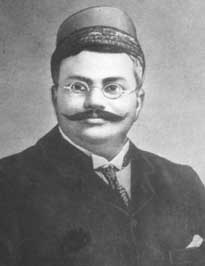|
When you only have a tantalising one-liner that goes “The first Parsis came to Madras in 1795 on a mission from the Rajah of Coorg,” you really don’t know what to make of it. Luckily, we can Google our way out of mysteries these days.

Seth Phiroj Muncherji Clubwala |
First, a brief account of Coorg, Tipu Sultan and the Company of the 1790s. While fighting the British during the Mysore Wars, Tipu was also trying to conquer Coorg. After many battles and skirmishes, the ruling King, Dodda Veera Rajendra, appealed to the English for help. A formal treaty was signed between the King and the Company in 1790. However, troubles and conspiracies continued and, in 1809, a much anguished and tormented Veera Rajendra passed away. His brother Lingara took charge.
A detailed and fascinating account of the tumultuous history of Coorg has been written by Hermann Moegling where there is clear mention of one “Parsi Hirji” who was part of a mission from the Rajah of Coorg which in 1809 presented to the Governor a portrait of the late Veera Rajendra. The memoirs recount that the Governor received the portrait graciously and the delegation was “dismissed”. For the purpose of this article, however, we will go with the earlier date of 1795.
Heerjibhai Maneckji Kharas was accompanied by five other Parsis and two priests. It is likely that their decision to settle in Madras was not pre-planned but taken after arrival. They bought a plot in Royapuram, opposite the Catholic Church.
What was Madras like in 1800? With Tipu dead, the troublesome wars were at an end. The French invasion was just a bad dream. The Nawab of Arcot, Muhammad Ali, willingly handed over administration of his territory in return for a pension. Company rule was firmly established over the region, more solidly than in other parts of the country. With the ensuing peace, the City began to move out of the Fort.
A couple of years after the Parsis settled in Madras, a ‘Dokhma’ (Tower of Silence) was built in a nearby plot. For years this Dokhma remained unused as, according to religious belief, the first body to be placed in it should be that of a child or a very elderly person. As there were no deaths of either at the time, the system of burial was adopted and the Dokhma was dismantled.

The Jal Phiroj Clubwala Dar-e-Meher |
On January 5, 1799, the partners of the firm Hormusji Edulji Panday obtained an additional plot of land from Governor Edward Clive and in 1814, when the number of Parsi settlers in Madras had increased, still more land was added, making in all about 32 grounds. The plot was leased out by the Company with a proviso that the lease might be renewed for a further period of 99 years on payment of a sum of 100 pagodas! The burial ground was in a portion of this land.
There is hardly any record of the next fifty years. On November 20, 1876, the Parsis formed themselves into an association known as the Parsi Panchayat. Eleven members were present at the meeting and a Committee of five members was elected to manage the affairs of the Panchayat. In 1893 Cawasji Panday was the first Parsi to be appointed Sheriff of Madras.
Fortuitously, when the Crown assumed Sovereignty in 1858, all lands leased out by the Company for a term of 99 years were deemed to be the property of the lessees. In 1895, the Collector of Madras transferred ownership of the plot in Royapuram to the President of the Panchayat. In 1900, this body was renamed as the Madras Parsi Zarthosti Anjuman. The property was referred to as Anjuman Bagh and many residential blocks were constructed over the years.
The Parsis of 1900 were, generally, a prosperous lot. From a fascinating account of the residents of Madras by Madhavrai Gigabhai Joshi in 1928, we learn of their various occupations. There were dealers of motor cars and cycles, perfumes and dyes. There were Government and Railway officials, managers of banks and shops. Some established soda water and ice factories.
Though two priests accompanied the first mission, there was no official priest in the community for over a hundred years and neither was there a place of worship. The first priest was appointed in 1906. When Master Jal, the young son of the philanthropist Phiroj M Clubwala, died, the grieving family donated a Fire Temple in his memory. This fire temple in Royapuram was designed by Hormusji Nowroji (a road in his name still exists in Chetput). The consecration of this temple on August 7, 1910 was covered in a detailed article in The Mail.
To honour Phiroj Clubwala after his death, the community in 1927 bought a building down the road called Greenfields and made it both a memorial hall and a club which was opened in 1930. The community now had a meeting place where they could participate in sports and cultural activities and celebrate festivals and marriages.
In 1995, the community celebrated the bicentennial of Parsi residence in Madras.
The Anjuman administers Anjuman Bagh, which serves as a dharamshala for travellers, besides more than 15 residential flats which provide subsidised housing for deserving members, especially senior citizens.
The community eagerly awaits the centenary celebrations of the Jal Phiroj Clubwala Dar-e-Meher (Fire Temple) in 2010.
The “Parsi Club” having been completely renovated in 1980 continues to be the watering hole of the community (around 250-strong) which meets at least once a month, in spite of the fact that most of the members have now settled in far-flung localities.
So many philanthropists have contributed to the development and growth of the community and many have enriched the fabric of the city. I will discuss some of them in the next part of this article.
(To be continued)
|